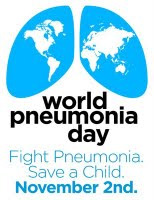
|  |  |  Health & Beauty | WHO India/Pakistan | November 2009 Health & Beauty | WHO India/Pakistan | November 2009  
Actions, Not Answers, Needed to Reduce Pneumonia Deaths
 Bobby Ramakant - Citizen News Service Bobby Ramakant - Citizen News Service
November 01, 2009


| | 1st World Pneumonia Day, 2 November 2009 |  |
Pneumonia claims two million children under five each year, yet no new drug, vaccine or special diagnostic test is needed to save their lives. The answers are at hand, and effective treatment is both inexpensive and widely available.

So why are children dying? This question is the driving force behind the first World Pneumonia Day (2 November 2009). The Global Coalition Against Child Pneumonia led by Save the Children has organised a Global Summit on Pneumonia in New York and other events around the world to mobilise efforts to stop a disease that kills one child every 15 seconds.

Actions, not answers, are needed to solve the problem, according to Penny Enarson, head of the Child Lung Health Division for the Paris-based International Union Against Tuberculosis and Lung Disease (The Union).

In an editorial “Who Speaks for the Children?” published this month in the International Journal of Tuberculosis and Lung Disease, Enarson et al point out that “recent data from 68 high-mortality countries showed that only 32% of children with suspected pneumonia receive antibiotics”. Other lapses in the delivery of care range from lack of trained staff and poor case management to inadequate stocks of drugs and faulty equipment.

Over the past decade, The Union has developed a service delivery model that addresses the key challenges in providing effective care for children with pneumonia. Based on the widely used Union model for tuberculosis control known as DOTS, the Child Lung Health Programme (CLHP) is based on government commitment, standard diagnostic and treatment guidelines, staff training, a purchasing and distribution system that ensures an uninterrupted supply of drugs, recording and reporting mechanisms, and supervision and evaluation.

The CLHP was first implemented by The Union in partnership with the Malawi Ministry of Health and Population. Between 2000 and 2005, the case fatality rate for children under five with severe and very severe pneumonia dropped 54.8%. By 2008, the rate had declined by 60%, demonstrating the sustainability of the model. The CLHP has also been implemented with good results in pilot programmes in Benin, China, Sudan and Tanzania.

“If we’re committed to reaching the Millennium Development Goal of reducing child mortality by 50% by 2015, we have to improve the way pneumonia is managed”, says Enarson. “The tools for saving these children exist. It is the political will to act and resources to support effective action that have been lacking”.


Bobby Ramakant is a World Health Organization (WHO) Director-General’s WNTD Awardee (2008) and a Fellow of Citizen News Service (CNS) Writers’ Bureau. Website: www.citizen-news.org, email: bobbyramakant(at)yahoo.com

|

 |
|  |



